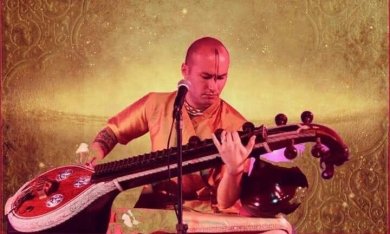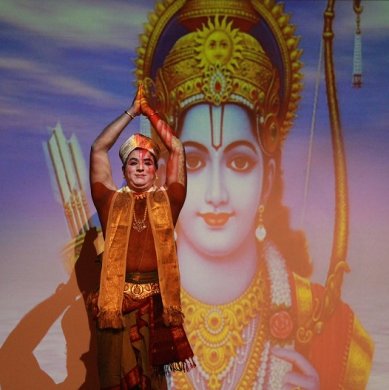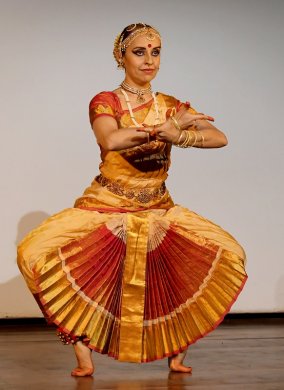
|   |

|   |
Abhivyakti hosts Abhivyakti Pradarshana in festival series - Sumangala Varun e-mail: sumangalavarun@gmail.com Photos courtesy: Abhivyakti January 22, 2020 Abhivyakti Cultural Center presented Abhivyakti Pradarshana on 20th December at Alliance Francaise, Bangalore. It is a part of the Abhivyakti National Festival Series that began in August 2019 and will culminate in June 2020. Abhivyakti is founded by husband-wife duo Odissi dancer Manasi Pandya and Bharatanatyam dancer Raghunandan. The artists for the evening included Brazilian nationals Bruno Tonelli and Karen Veloso, Samhita Kashyap, Niharika Gowda, Anjali Hariharan and Raghunandan S. The speakers for the evening included film maker Hariharan Krishnan, agricultural entomologist Dr. Rajendra Hegde, and photographer Madhusoodhan S.  Baladev Nithai The evening began with Bruno’s music concert. He goes by the name Baladev Nithai. Dressed in a saffron panche and uttariya, Nithai began his performance with a detailed introduction on his musical journey. He spoke in length about how his father introduced him to music, and how a chance trip to India with his band took him to Indian classical music and philosophy. His first item was a self-composed piece based on the Shikshashtakam, verses composed by Chaitanya Mahaprabhu. He played the guitar as he sang. Nithai then proceeded to present his maiden veena concert in India. He presented a self-composition of excerpts from the Ishavasyam. His efforts were commendable. If he continues his training and is diligent with his practice, he can establish himself as a performer. Samhita, a disciple of Manasi, and Niharika, a disciple of Raghunandan, proceeded to explain the characteristic features of Bharatanatyam and Odissi through angika abhinaya. They effectively brought out the usage of the head, neck, chest, hands, torso, waist and legs. They demonstrated how each anga comes into play in adavus, nritta and abhinaya pieces, and various rasas like veera and bhayanaka. They concluded their demonstration with a pallavi-thillana in Vasantha raga, a confluence of Odissi and Bharatanatyam. Their performance was marked by strong movements rooted to their respective dance forms, indicative of the good training they have received. Samhita, a trained vocalist, impressed the audience when she sang as she danced, with very little fatigue to show for it. After the lec-dem, the dignitaries lit the lamp, and Manasi gave the welcome address and a brief description of the festival series.  Anjali Hariharan Up next was Dr. Anjali Hariharan with an Odissi performance. Hariharan, a disciple of Manasi, is a homeopathy doctor and a yoga practitioner based in UK. She began with a Ganesha Vandana in ragamalika. Her second item was a piece based on the ashtanayikas. The nayika began as a vasakasajjika as she gets ready to greet her lord. However, her avastha changes into vipralabdha when she realises that her lord has spent the night with another woman. Anjali conveyed the abhinaya well with her pleasant face. Raghunandan, co-founder of Abhivyakthi, presented a solo production on the Aranya Kandam from Tulasidas’ Ramacharithamanas. In his introduction, he mentioned that Tulasidas chose to write in Awadhi language to reach the masses. He mentioned that Aranya Kandam is a favourite of dancers as it has a lot of scope and possibilities for abhinaya. He explained how he has used properties to distinguish between characters. While the presentation is in Bharatanatyam, there are influences of other dance forms like Odissi and Kathakali. The piece has also used multimedia including voiceovers to make it easier for viewers to understand. Srishukha has composed the music. The segment began with an audio-visual introduction to Tulasidas. The first sequence was Atri Milan, where Rama, Sita and Lakshmana meet with sage Atri. Rama defeats the asuras who torment the sages. Atri presents Sita with divine ornaments and robes that would always remain clean and new. The incident with Shoorpanakha was the next sequence. Raghunandan used karanas to portray Shoorpanakha presenting herself as a lovely lady. Sita Apaharana was the third sequence and it began with Ravana presenting a brisk and energetic jathi. Ravana wore a crown and carried a mace. Mareecha as the golden deer was depicted with deer horns attached to a Mysore peta. The final sequence of the presentation was Shabari upadesha. The old and wizened Shabari is awaiting Rama’s arrival. After savouring the fruits, Rama goes on to elaborate the Navadhabhakthi or the nine steps of devotion to Shabari. It was a delight to watch the transition from Shabari to Rama for each step of the conversation. Raghunandan maintained his energy level throughout the recital and took on every character and convincingly depicted them. The segment concluded with an arathi to the lords.  Raghunandan  Kamalakshi Rupini Brazilian native Karen Veloso who goes by the name Kamalakshi Rupini gave a Bharatanatyam presentation. A disciple of Guru B. Bhanumathi since 2007, Kamalakshi began her recital with a Choornike followed by a Poorva Ranga Vidhi of the Mysore style. The unique item gave the dancer scope to display her expertise on nritta. Kamalakshi concluded her recital with an ashtapadi Sakhi he choreographed by Bragha Bessell. She essayed the role of the sringara nayika with ease, displaying Guru Bhanumathi’s stamp of excellence. The next segment saw experts from photography and film making speak about the influence of dance over their field and vice versa. Filmmaker Hariharan Krishnan said that the only way to do justice to a dance performance is to shoot it as it is without any cuts or close-ups. However, this would get monotonous and would not be able to capture the essence of the performance. He suggested that film making is akin to choreography as it involves orchestrating multiple factors to a single point.  Hariharan Krishnan  Madhusoodhan S Dr Rajendra Hegde, Agricultural Entomologist, spoke about how it is possible to create green patches and live sustainably in metro cities like Bangalore. He also urged the listeners to reduce waste and limit the use of disposable products. Leading dance photographer Madhusoodhan S spoke about how still photography and editing techniques aid dance. He mentioned that still photos serve both as a record and a guide to help dancers modify their performance. He also spoke about the benefits of editing. Using multiple pictures and suitable editing can help create images like the Vishwaroopa using a single dancer. Manasi and Abhivyakthi are doing a great job in conducting such festivals that lets the rasikas hear from experts from supporting fields like cinema and photography. Sumangala Varun is a dancer and a freelance writer from Bangalore. |